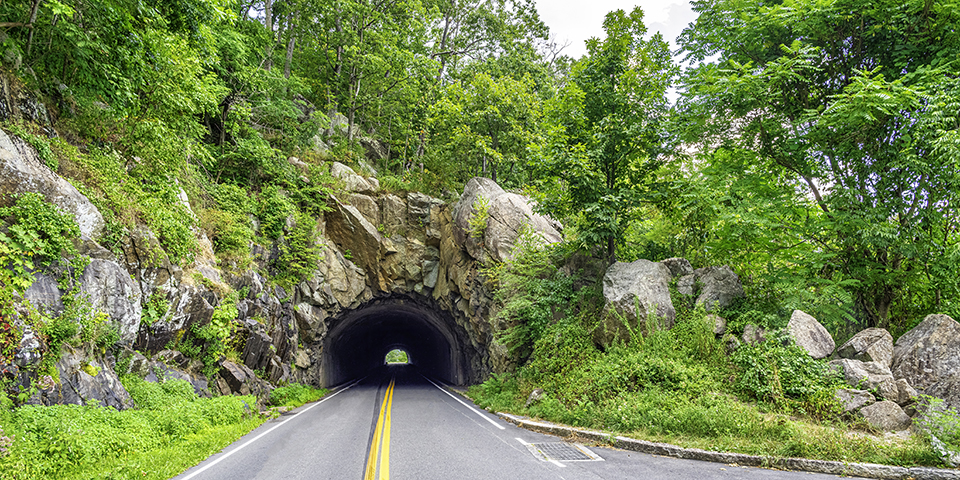VIRGINIA
The Old Dominion has roots that reach back to the Colonial era — and rugged landscapes that have remained unchanged for millennia. Take a trip into an incredible past.
Blue Ridge Parkway/Shenandoah Valley
Two scenic Virginia destinations beckon travelers to the Old Dominion. Add the Blue Ridge Parkway and Shenandoah Valley to your travel itinerary on your next trip to Virginia.
Back on the Blue Ridge
Known as “America’s Favorite Drive,” the Blue Ridge Parkway has been the most popular destination in the National Park System nearly every year since 1946, and it’s easy to see why. Free of truck traffic and tracing the Appalachian Mountain ridgeline for hundreds of miles, the scenic route is brimming with mesmerizing vistas that stretch as far as the eye can see. Photogenic historic sites and charming small towns that are home to some of America’s most distinctive arts and crafts traditions.
See the Rocks
Just six miles from the northern entrance to the parkway, near the town of Waynesboro, a hike to Humpback Rocks offers the perfect introduction to the spectacular landscape. The two-mile hike to the mountain’s rocky peak, though steep, is short and accessible for beginning hikers. Along the trail, you’ll pass historic 1890s farmhouses that have been repurposed as open-air exhibits of life in the Virginia mountains. The hike culminates with an outcropping that provides 360-degree views of the hazy, azure skyline that gives the Blue Ridge Mountains their name.
Shenandoah Valley
Once lauded as America’s first frontier, the Shenandoah Valley is home to distinctive small towns, expansive vistas and some of the country’s most revered historic sites. From museums to music festivals to marathon hikes, the “Big Valley” is a four-season destination that encompasses nearly 200 miles of unmatched beauty and rural charm. There’s a surprise around every corner.
Regional Recipe
Strawberry Pie
Here’s a one-crust strawberry pie that’s a refreshing taste treat. Easy to make, too. Recipe adapted from Woodall’s Campsite Cookbook.

Getty Images
Ingredients:
- ½ pckg (2-crust size) pie crust mix
- 3 cups fresh strawberries, cleaned and hulled
- ½ cup sugar
- 2 tbsp cornstarch
- dash salt
Directions:
Prepare single pie crust as directed on package. Bake and cool. Crush 1 cup strawberries Place in saucepan with sugar and cornstarch and cook until thick and syrupy. Fill baked cooled pie shell with remaining 2 cups of berries; cover with hot syrup. Chill and serve.
River Fun
The Shenandoah River, which meanders the length of the valley floor, is a popular paddling and recreation corridor that boasts smooth water and grassy banks. Outfitters in Luray and other points along the river are on hand to help arrange kayaks, canoes, inner tubes and rafting trips along different stretches of the waterway. Anglers, too, can try their hand at the trout and bass that call the river home.
Shenandoah Vintages
The Wisteria Farm and Vineyard in Stanley uses only Virginia-grown grapes to produce whites and reds that are quickly becoming favorites of the region’s wine lovers. In addition to tours and tastings, you can bring a picnic and wander the lush grounds of the scenic farm at your leisure. Barren Ridge Vineyards and Peaks of Otter Winery are also favorite vineyard visits that offer tours and tastings.
Rocky Outcrops and Waterfalls
The choices are endless when it comes to hiking in the area, with high rock outcroppings that dish out stellar views in nearly every direction. There are plenty of treks that lead to spectacular waterfalls, too. Explore a dramatic gorge on the way to White Rock Falls, capture photos from the top or base of Crabtree Falls or enjoy a refreshing shower under the Apple Orchard Falls in the summer.
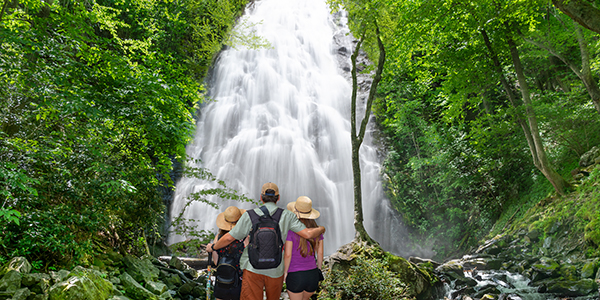
Family relaxing and enjoying beautiful view on a vacation hiking trip. Father with arms around his family looking at waterfall. Crabtree Falls just off the Blue Ridge Parkway. North Carolina,
The Best of Bluegrass
Did you know the Blue Ridge Parkway region has produced more bluegrass musicians per capita than any other place? You can dive into the region’s rich music heritage at the Blue Ridge Music Center in Galax. Learn about the history of the music genre through films and interactive exhibits and stay for live performances by local artists. The Blue Ridge Folklife Festival also takes place on the fourth Saturday of October and has been celebrating music and folk traditions for nearly half a century.
Magnificent Mabry
No trip along Blue Ridge Parkway is complete without a visit to Mabry Mill. This structure once operated as a sawmill, gristmill and community center for the Meadows of Dan region. Today, it’s a gathering place for musicians and dancers on Sunday afternoons. Walk on the trail near the mill to find historical exhibits.
Cool Carvins Cove
Set aside some time at Carvins Cove Natural Reserve. Ranked as the second-largest municipal park in the nation, this vast expanse is threaded with 60 miles of trails for biking and hiking as well as a large reservoir for fishing.
Historic Triangle
Brimming with living history museums, fascinating monuments and Colonial towns, the Historic Triangle of southeast Virginia transports you to America’s pivotal historic moments. Start your journey in Jamestown to explore North America’s first permanent English settlement. Following northeast along the Colonial Parkway will take you to the triangle’s apex, Williamsburg, a Colonial town that roiled with revolutionary fervor in the 1770s. Go southeast along the same parkway and you’ll wind up in Yorktown, the spot where American forces won a pivotal battle against the British Empire. Visitors will acquire a new appreciation of the pivotal moments in America’s history.
Colonial Roads Take You Home
Let southeast Virginia’s Colonial Parkway take you on your trip through the past. The north tip of the Historic Triangle (Williamsburg) is only an hour’s drive east from Richmond on Interstate 64. You can start your American Revolution adventure here, or carry on to the Colonial Parkway. If you’re coming up from the south through Norfolk, Interstate 64 is your best bet for heading straight to Williamsburg. Veer off to the east on U.S. Route 17 if you’d rather begin in Yorktown. Plan to visit in May, June or September, when temperatures aren’t too hot, because you’ll be doing plenty of walking and reenacting at Colonial Williamsburg, a 300-acre living history museum. This is a great trip for kids, because it mixes fun with lots of history lessons.
Lifestyles of the Colonial
Start your Historic Triangle adventure in the place where it all began: Historic Jamestowne, located on the James River near the Atlantic. This living history museum immerses you in 17th-century Virginian life, thanks to recreated British ships, a Powhatan Native American village and more.
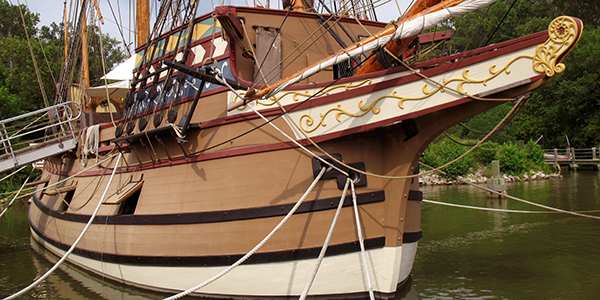
Powhatan Village
Begin by watching “1607: A Nation Takes Root,” a film that reenacts the landing, and then visit exhibition galleries for an in-depth overview of Jamestown’s beginnings. Afterward, make your way to the Powhatan Indian Village to gain insight into the indigenous way of life. Learn about Pocahontas, the Native American woman who played a pivotal role in the colony’s success. Demonstrations show how the Powhatans made food, tools, cordage and more. Walk past the village, and you’ll stumble upon replicas of the Susan Constant, Godspeed and Discovery, the first ships to arrive in Virginia and start the permanent English colony.
Ship Ahoy
Step aboard the moored vessels to learn how sailors piloted the ships during their journey and to see what shipboard life was like. Costumed interpreters add to the experience, and visitors will even get to try steering with a whipstaff — the predecessor to the steering wheel — or tiller. Learn about the struggles and dangers faced by the passengers on the vessel. Finish your journey at the recreated James Fort.
European Settlement
Featuring an Anglican church, court of guard, storehouse, governor’s house and many thatched-roof houses, this fort takes you back in time to 1610-1614. Exhibits educate visitors about the trials endured by settlers who braved the tough conditions of the New World. During your stay, you’ll get to put on armor, play games, try your hand at farming and watch interpreters make wood and leather goods.
Williamsburg: Window to the Past
Colonial Williamsburg is a sprawling “city” boasting an entire neighborhood of original buildings, replicas of colonial homes and reconstructed trade shops and taverns. Experience what life was like in the 1770s as you tour 88 authentic colonial buildings and 90 acres of picturesque gardens. While you’re here, see where Patrick Henry gave his famous “give me liberty or give me death” speech. Walk in the footsteps of Thomas Jefferson and other revolutionaries who strove for independence.
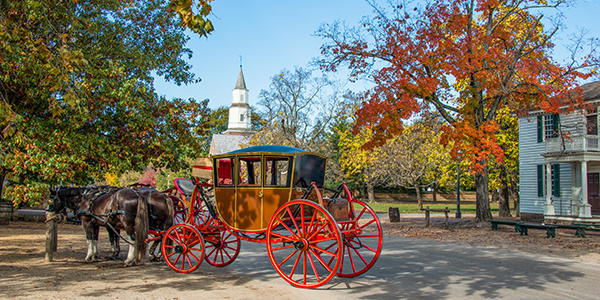
A horse drawn carriage along the street in Williamsburg in the Fall.
Bringing the Past to Life
Costumed interpreters add authenticity to the streetscapes, as shopkeepers, marching soldiers, tavern patrons and farm families never break character. Here, you’ll also find the DeWitt Wallace Decorative Arts Museum. Meander through its halls to see an impressive array of British and American antiques from the 17th to 19th century. Featuring everything from ceramics and furniture to firearms and art, this museum gives you an even deeper glimpse into vibrant colonial life.
Famous Faces
During your visit, you can see famous figures such as Benjamin Franklin walk the streets as the Revolutionary War gains steam. Hear fiery speakers` exhort the crowd and watch the local militia march out to face the British. Colonial Williamsburg offers evening programs that focus on witch trials and ghosts.
Dose of Adrenaline
After exploring Colonial Williamsburg, pop into the present and head to nearby Busch Gardens Theme Park for the ultimate adrenaline rush. Ride pulse-pounding roller coasters, savor phenomenal dining options and take part in fun events.
International Fare
If you’re here in the spring, attend the Busch Gardens Food and Wine Festival. Not far away is Water Country USA, the largest waterpark in the mid-Atlantic. Cool off during the hot summer months on over 40 slides and water rides.
Battlefield of Yorktown
Nestled along the York River, visit the site of the 1781 Siege of Yorktown, in which forces led by General George Washington vanquished the British army. Today, it’s part of the Colonial National Historic Park, with the Yorktown Victory Center and Yorktown Battlefield open to the public. Within the Yorktown Battlefield is the visitor center, which plays the 16-minute “Siege at York-town” film. Peruse the museum showcasing George Washington’s field tent and other intriguing artifacts from the battle.
Under Siege
Outside, take a guided or self-guided tour to see the siege lines and visit the place where terms of surrender were accepted. Another popular attraction here is the American Revolution Museum at Yorktown. Home to dynamic exhibits, films and outdoor living history, this museum covers colonial beginnings leading up to the creation of the Constitution. Play with interactive exhibits, watch artillery demonstrations or drill with wooden muskets in the outdoor living history section.
There’s Wildlife, Too
Uncover the wild side of the Historic Triangle at College Landing Park in Williamsburg. Set on the shores of College Creek, the park is threaded with trails that wind through lush marshlands and a lookout tower; watch for a variety of birds as you stroll through the landscape.
Paddle the Powhatan
Near Jamestown, you can paddle to your heart’s content in Powhatan Creek Park and enjoy stunning views of Jamestown along the way. Cast a line from your boat or from one of five fishing piers to catch spotted sea trout, black sea bass, bluefish, catfish, largemouth bass and more. You can also take in the area’s spellbinding landscapes at a slower pace by cycling the 23-mile Colonial Parkway. If you want to take it even slower, play 18 leisurely holes or practice your swing at the handfuls of golf courses nearby. Near Yorktown, boaters can hit the current on the York River, stretching 34 miles and feeding into Chesapeake Bay.
Indulge in Art and Shopping
The Historic Triangle is home to riveting living history museums, but there’s so much more to this part of the Virginia peninsula. Gaze at the world’s largest collection of Southern furniture and impressive British ceramics at Williamsburg’s DeWitt Wallace Decorative Arts Museum.
Art on Tap
The town also houses one of the biggest collections of American folk art in the world. The Abby Aldrich Rockefeller Folk Art Museum showcases exquisite portraits, quilts, toys and more from the 18th, 19th and early 20th centuries. Take a break from the history lessons by shopping at Williamsburg Premium Outlets. Boasting top names like Nike, Banana Republic, Coach, Gap and J. Crew, this outlet mall offers incredible deals on quality clothes and accessories.
Fuel for the Mind and Stomach
You can feast like American revolutionaries did thanks to an overload of delicious eateries. Stop by a replica of George Washington’s favorite seafood joint, Christiana Campbell’s Tavern, and devour their signature crab cakes just like the former president did. Dine like 18th-century royalty at the King’s Arms Tavern, Colonial Williamsburg’s most elegant restaurant. Costumed waiters serve up early American cuisine such as game pie, venison, rabbit and duck braised in port-wine sauce, while serenading guests with live traditional music. Festival season kicks off in spring with everything from art displays and concerts to garden tours and wine tastings.
The Virginia Shoreline
That relaxing beach vacation you’ve been dreaming of isn’t as far away as you think. Set where Chesapeake Bay meets the Atlantic Ocean, Coastal Virginia has all the makings of a dream holiday. Balmy beaches, two state parks, blue crab feasts, rich history and an overload of entertainment options come together to spoil adventurers, fun-seeking families and city slickers looking for an escape.
A Sunny Escape Close to Home
Located in the southeast corner of Virginia, this coastal paradise runs from Norfolk down to the North Carolina border. It’s not hard to get here, as major hubs like Washington, D.C., Raleigh, Durham and Baltimore are all within 240 miles. If you’re coming from the west, the best highways to take include Interstate 64, U.S. Route 460 or U.S. Route 58. Arriving from the north? Take the Chesapeake Bay Bridge-Tunnel for an unforgettable drive. This 23-mile engineering marvel connects the Virginia mainland to its eastern shore, and offers sweeping views overlooking Chesapeake Bay. The region enjoys approximately 200 days of sunshine a year and boasts a year-round average temperature of 60 degrees.
Wild Encounters
Take a walk on the wild side in Back Bay National Wildlife Refuge. Boasting 9,100 acres of woodland, marsh, dunes and beach, this complex of barrier islands supports a diverse range of animals. Stroll along its many scenic trails to see foxes, deer, bobcats, sea turtles and bald eagles. Bordering the refuge is Little Island Park, an excellent spot for viewing diving ducks and Atlantic bottle-nosed dolphins. Sunseekers can enjoy swimming, volleyball, tennis and canoeing in nearby Lotus Garden, too. The Chesapeake Bay supports more than 3,600 species of plants and animals, including 348 species of finfish, 173 species of shellfish, over 2,700 plant species and more than 16 species of underwater grasses. Rockfish are a staple in the bay and there are plenty of ways to reel them in. Launch your boat from various ramps, take a private charter or drop your hook from the local fishing piers.
Broaden Your Horizons
Beachgoers aren’t the only ones who will have fun here. Lined with restaurants, shops, hotels, street performers and a Ferris wheel, the 3-mile Virginia Beach Boardwalk brings fun with every step. Along the way, visit the Military Aviation Museum, Virginia Museum of Contemporary Art (MOCA), and the Virginia Aquarium & Marine Science Center. Snap a photo with the iconic King Neptune statue on 31st Street.
Find Your Beach
What many people don’t know is that Virginia Beach is actually made up of three beach areas. Each offers a completely different experience. The most famous is the “resort area.” Here, you’ll find the city’s most popular stretch of shoreline and attraction-packed boardwalk. Those who want to escape the hustle and bustle can seek peace in the quiet, shallow beaches along Chesapeake Bay. Top spots here include Cape Charles Beach, Ocean View and Huntington Park Beach. Get off the grid completely by going to the secluded beaches of Sandbridge.
Coastal Getaway
A popular excursion is to sign up for a tram tour from Little Island Park in Sandbridge along the West Dike Trail and through Back Bay National Wildlife Refuge before culminating at False Cape State Park in Virginia Beach’s southeast corner. One of the last undisturbed coastal environments on the East Coast, this stunning mile-wide barrier split between Back Bay and the Atlantic Ocean comprises 6 miles of pristine beaches, 9 miles of hiking/biking trails and a highly praised environmental educational center.
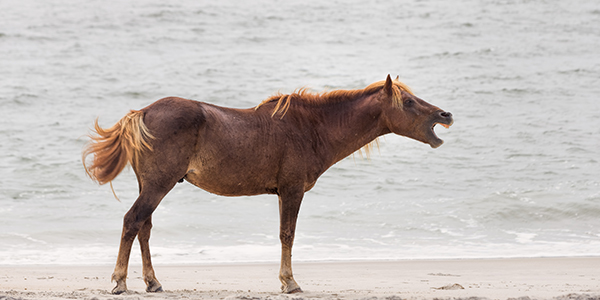
A Wild pony, horse, of Assateague Island, Maryland, USA on the beach.
The Chincoteague Wild Pony Swim
If you’re in town during late July, it’s worth making the journey to Chincoteague Island for the legendary Chincoteague Wild Pony Swim and Auction. Local firefighters gather wild ponies from Assateague Island and herd them across the channel — yes, ponies can swim — to Chincoteague Island. From there, the horses are paraded down Main Street and then auctioned off at the carnival grounds. With a population of only about 3,000, the island boasts a small-town feel and relaxed pace of life. Seven miles long and three miles wide, the island packs a lot of recreation possibilities in a relatively small space. Fishing, biking and hiking are plentiful on the island, and more adventurous souls and try hang gliding (accompanied by a professional hang-gliding pilot, of course).
Wallop of Marine Life
Along the Virginia Shoreline, visitors can have their pick of good times. Directly west of Chincoteague Island is Wallops Island, home to the Marine Science Consortium. The field station’s programs teach guests about marine life and the Wallops Island ecosystem through interactive programs for children and adults. Wallops is also home to NASA’s primary facility for suborbital research programs. The Wallops Flight Facility visitor center hosts free public education programs as well as weekly activities, and it is an ideal viewing site when rockets are launched.
Water Trail
Prefer paddling to planes? Visitors can take a canoe or kayak out on the water for a slow-paced tour along the Virginia Seaside Water Trail. Essentially 100 miles of day-use paddling routes, the trail’s 37 water courses stretch between Chincoteague Island and the Virginia National Wildlife Refuge to the south of the peninsula. North and South Raccoon Island are the recommended for beginner paddlers.
Beautiful Cape Town
Located on the shores of the Chesapeake Bay on the west side of the Virginia Shoreline peninsula, Cape Charles delights visitors with its resort feel and small-town charm. Cape Charles was established in 1884 to serve the Pennsylvania Railroad. Cape Charles Museum and Welcome Center offers a compelling window into this area’s past. Watch the 4-foot-long model locomotive as it traverses its loop track. The museum also houses artifacts from the formation of the Chesapeake Bay crater, models of sailing ships and archival photographs from the town’s development projects. Though the trains have long gone, traffic continues to come to Cape Charles in waves of tourists seeking ocean-side relaxation and fun. Cape Charles boasts a fantastic beach, and the southern end is adjacent to a public pier for saltwater fishing and watching boats sail through the Chesapeake Bay.
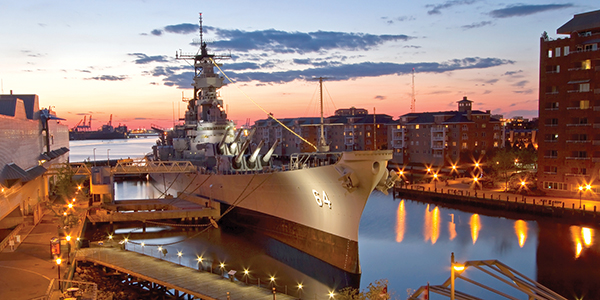
Docked in Norfolk, the USS Wisconsin is a World War II-era battleship that is open for touring.
Norfolk
In the throes of a renaissance, the town of Norfolk is known nationwide for its military presence. Home to the largest navy base in the world, as well as one of NATO’s two Strategic Command headquarters, Norfolk has cast off its reputation as a dubious port of call and now offers all the poise and trappings of a charming coastal town. There are pavement cafés in the historic village of Ghent, a revamped Waterside District with eclectic waterfront stores, a thriving arts scene and several worthy cultural institutions. It’s worth your time to make a side trip to Norfolk.
Seaside Treasures
Located amid Norfolk’s bustling docks, the stellar Nauticus Museum features the USS Wisconsin, a World War II-era battleship that saw action in the South Pacific. Walk the decks of this formidable vessel on a self-guided tour, or take a guided journey topside for a glimpse of maritime history. Just 1 mile north, the Chrysler Museum of Art is hailed as one of North America’s most prestigious art museums. Chrysler’s dazzling collection includes works by Renoir, Rubens, Picasso, Cézanne, Matisse, Warhol and Pollock, as well as a decorative-arts collection with art nouveau furnishings and glass objects spanning the 6th century B.C. to the present. Don’t miss the glorious Tiffany glassworks, French art glass and English cameo.
For More Information
Virginia Tourism Corporation Tourism
804-545-5500
www.virginia.org
Blue Ridge Parkway Association
828-670-1924
www.blueridgeparkway.org
Historic Triangle
www.virginia.org/getawayHistoricTriangle
Eastern Shore of Virginia Tourism
757-331-1660
www.esvatourism.org
